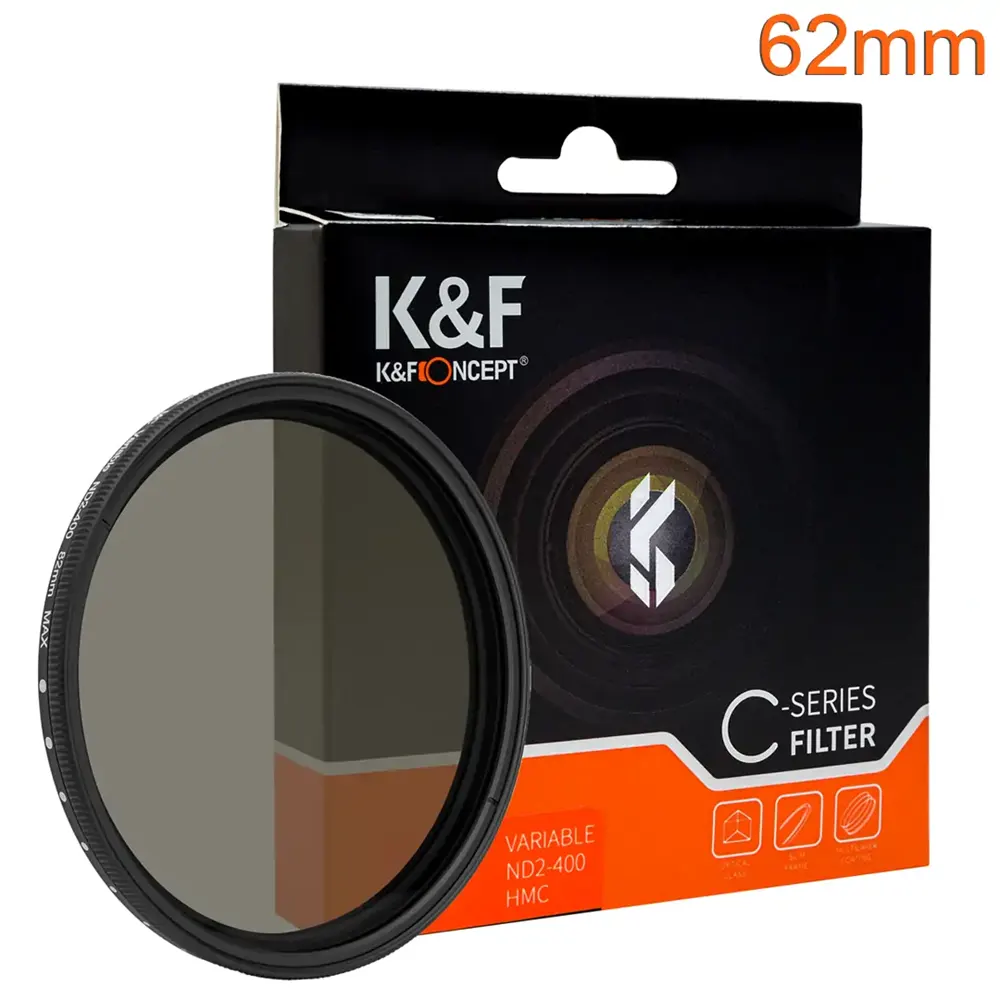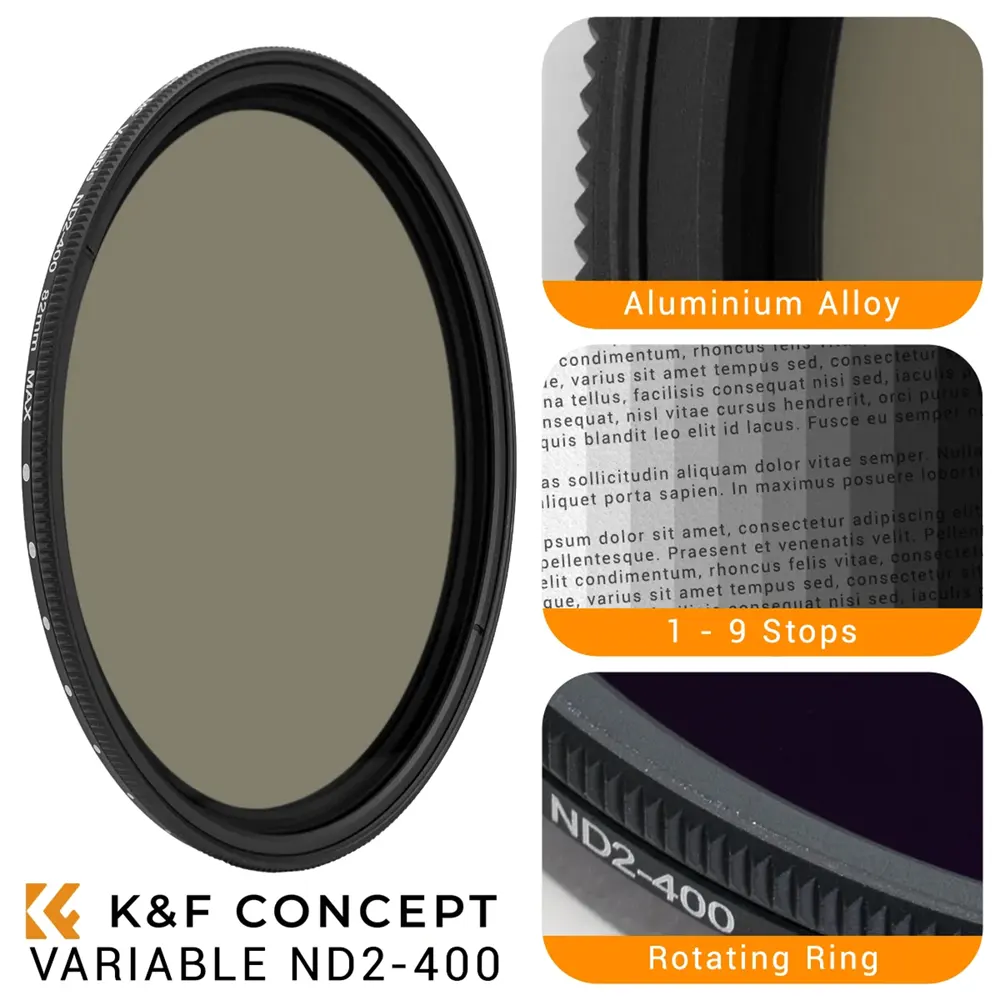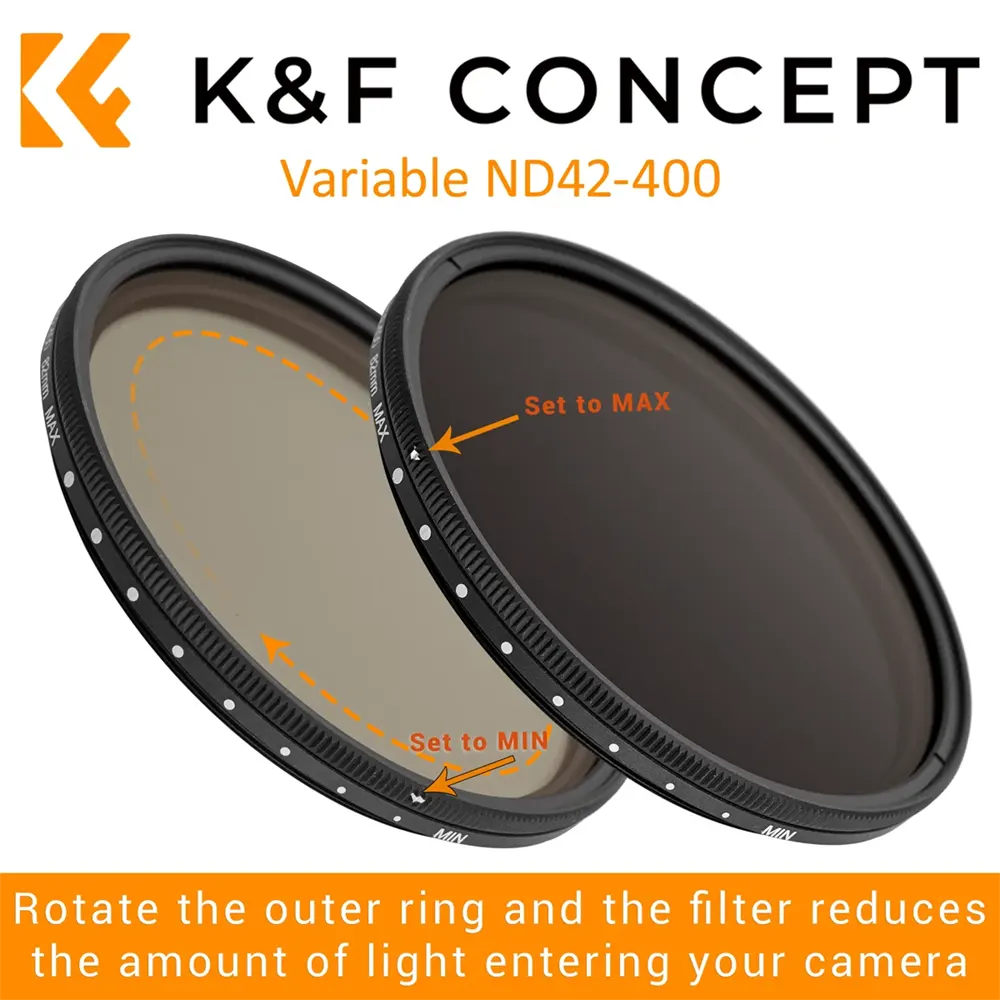K&F 62mm Variable ND Filter; ND2-ND400 from 1 to 8 F-Stops
R599
Includes VAT | Shipping options at checkout
An ultra slim Variable ND, exposure control at your fingertips, simply rotate to reduce the amount of light
MAIN FEATURES:
- Variable from 1 to 8 f-stops of light reduction for ultimate exposure control
- Extend exposure times or achieve shallower depth of field
- Ultra slim and lightweight frame
- High-quality metallic frame construction, with smooth action
- Japanese high precision optical glass with double-sided polishing
- Multi-layer coating for reduced reflection, anti-glaring and higher transmittance
- Double sided coatings are waterproof and scratch resistant
- Includes plastic carrying case to protect against scratches and dust when transported
What’s in the box:
1 x K&F 62mm Slim Variable ND filter ND2-400
1 x Plastic carrying case
CHECK ON STOCK AVAILABILITY FIRST


Shop Online
and fill your cart
Choose Payflex at checkout
Get approved and
pay 25% today
with your debit
or credit card
Pay the remainder
over 6-weeks.
No interest.
No fees.
Master light with up to 8 f-stops of exposure reduction, control the light and elevate your photography game
The K&F Variable ND filter gives you additional control over your exposure. This allows you to blur movement or decrease depth of field, normally impossible in the bright harsh light of day. It can restrict the amount of light entering the camera allowing you more choice in your preferred settings. Now you are able to shoot with longer exposure times or wider apertures under bright conditions. A Variable ND differs from a normal ND filter in that you can control the amount of light reduction simply by rotating the filter.
A Variable Neutral Density Filter is like a pair of sunglasses for your lens. A pair of sunglasses that you can adjust like a volume knob to control the amount of light they let through. Cameras have three ways to control exposure, aperture, shutter speed, and ISO. This filter effectively becomes a fourth control tool to manipulate light exposure. It controls the amount of light that enters your lens by opposing two polarised filters. Rotating one creates a darkening effect, which ranges in influence from 1 to 8 f-stops of light reduction. By reducing the amount of light entering the lens and sensor, a photographer can create several awesome visual image effects. These effects would not be possible in bright light conditions without a variable ND. Simply adding the filter to the lens gains you your first f-stop reduction of light. If you have ever visited a beach, desert or salt flats you will know how much you appreciated having sunglasses with you. Under those extreme lighting conditions you camera sits with all its exposure controlling settings topped out. The amount of artistic control you can take becomes limited by the restriction of all values being maxed. Adding dialable sunglasses to your camera reopens creative possibilities.
Using the K&F Variable ND Filter can benefit you in four ways. It can allow you to extend shutter durations to create movement blur. It can allow you to open your aperture wide so you can achieve shallower depth of field. It can be used like an aperture ring to control exposure. It also reduces the amount of equipment you need to carry as 1 Variable ND can take the place of several standard ND filters.
Slow your Shutter and Extend your Exposure times
Reducing the amount of light with a Variable ND filter allows you to increase the shutter duration. Slow shutter speeds create a motion blur effect. With this motion blur effect, you can perfectly contrast the static and moving subjects in your images. Static elements remain frozen, whilst moving elements become blurred. Motion blur is the perfect way to highlight dynamic elements in your shots. This leaves you with endless creative possibilities when photographing scenes with isolated moving elements. Here are a few ways in which you can use the K&F Variable ND Filter to capture moving scenes:
- The variable ND is valuable for landscape photographers when used to capture scenes with clouds and sky elements. The filter can blur the motion of moving clouds. This makes moving clouds appear much more dramatic, streaky and surreal. This makes for much more eye-catching images with visual intrigue that will hook your audience from the first glance.
- Another one for the landscape photographers. If your subject contains water in motion, such as trickling streams, cascading waterfalls or the ocean battering the shoreline. Then you can count on the K&F Variable ND to increase your exposure times capture silky, softened, smooth, foggy, dreamy or blurred effects from water. These effects will help you add drama to your scenes and move your audience with the majesty and grace of moving water, without any distracting overexposure.
- If cityscapes are your thing, you will find this filter earning its place on the front of your lens. When shooting in daytime, you can perfectly capture crowds of moving people and vehicles, or clouds floating between the city skylines. When shooting in night-time you can get those streaking vehicle and city light shots you have always dreamed about taking. Using the motion blur effects for cityscape shots helps to add atmosphere to images that may otherwise appear flat or static.
The second major benefit of shooting with the K&F Variable ND Filter, is the shallow depth of field you can achieve. Reducing the amount of light with a Variable ND filter allows you to open your aperture, allowing for shallow depth of field, isolating your main subject and producing a soft blur look in your background. Widening your aperture lets more light into your sensor. Usually, widening your aperture leads to overexposed images in daylight conditions. This is where the variable ND filter becomes worth its weight in gold. By reducing the amount of light entering your sensor by several f-stops, you can take striking images with great subject and background separation through blur, without overexposing. Here are a few ways in which you can use the K&F Variable ND Filter to capture images with a shallow depth of field:
- By widening your aperture, you can take stunning portraits. You can isolate the person in your images to be the sole focus of your image in the foreground. With the background softly out of focus and no overexposure.
- The effects of this filter are well suited to stylised product photography, with perfect isolation of the product as focal point.
- For outdoor photographers, the same foreground isolation effects are very valuable, especially when photographing foliage and fields. With an ND lens filter helping to block out light, it’s easier to add visual intrigue by capturing a shallow depth of field. Animal or bird images can be brought to the fore without any background interference when using this filter.
- In urban setting the variable ND effects will help you control light exposure in the different layers of your image.
Thirdly for videographers a Variable ND filter gives you an aperture control ring right at your fingertips. Most lenses don’t have a separate aperture ring. Aperture is now controlled by a rolling wheel somewhere on the camera body. Quite often when a camera is recording it will disable aperture changes until the recording has stopped. DSLR cameras have become popular for video work, but they can have restrictions making video creation hard to do well. If you are looking to step up your game behind the lens and add a more cinematic style to your shots, a Variable Neutral Density filter may be a great option for you.
Lastly, it helps you streamline the amount of gear that you must carry to your shoot location. You will also spend a lot less time swapping out filters. This becomes very valuable when you have limited time to take your shots. Missing the perfect opportunity for a perfect shot because you are still busy installing the appropriate filter is an excuse of the past. You can buy ND filters in a range of densities and swap them out as needed. Or you can use the K&F Variable ND Filter to replace individual filters as a great all-rounder in you ND filter arsenal. Making the K&F Variable ND Filter the perfect ND filter for photographers who are on the move.
The K&F Variable ND Filter has a smart ultra slim frame design machined from the best quality aircraft aluminium. This ensures the frame is strong, durable and also very lightweight. It will stand up to continuous use, day in and day out. The textured frame helps to add extra grip to the surface. You can screw it on securely with less risk of accidentally dropping the filter and you can rotate it more easily to dial in the value you after. The smooth action allowing perfect light reduction between 1 and 8 f-stops. There are no hard stops, so you can intuitively dial in the darkening effect with your eye. You will also find handy dot and arrow calibration marks to help make results repeatable. The frame is double threaded so you can combine the effects of more than one filter type, allowing you to adapt the mood and atmosphere to fit any occasion or condition.
The filter lens is crafted from high precision Japanese optical glass. The lens is treated with a double-sided polishing process which ensures high-definition image quality at up to 8k. The filter also undergoes a double-sided multilayer coating process where 18 layers is applied to the lens. The most prominent of these coatings, is the anti-reflection coating. This coating effectively reduces reflection from both the ground and from within the filter itself. The coatings also increase effective light transmittance through the filter and avoids ghosting. The outer layer coating is a double-sided blue coating to help repel water and are scratch resistant ensuring the longevity of your filter. The lens is fused into the frame using a high-pressure press process. It will never come loose, even when being subjected to external forces. The filter glass is larger than the threaded mount to further help reduce vignetting, even when using a wide-angle lens. It also helps give a filter effect which is consistent over the entire frame.
Using the K&F Variable ND Filter is very easy. Simply match up the threads on your lens with the threads of the filter and screw together. You will find that the textured surface really adds a lot of grip. The density of the filter effect is adjusted by rotating the outer frame. Rotate the frame one direction to reduce the amount of light entering your lens, rotate it back the other way to let more pass through and reduce the darkening effect. As Variable ND filters are constructed from two opposed polarised filters, rotating the filter beyond its maximum range could produce a cross effect. The last dot represents the point at which an X could begin to form over your image and you should back off a little. Similarly, the combination of polarisers can shift colours from being neutral.
Screwing this variable ND filter on the front of your lens will help you manipulate and control the amount of light that enters your lens and sensor. With the K&F Variable ND Filter in front of your lens, you have a world of creative possibilities at your fingertips. From motion blur effects to shallow depth of field, you can do it all with the K&F Variable ND Filter. It’s got you covered from 1-8 f-stops. So, if you are trying to streamline the amount of gear you carry to your shooting location or just need a great all-rounder ND, buy the K&F Variable ND Filter now. As with all K&F products, the price will put a smile on your face. Comparable ND filters from other manufacturers could cost you double.
Specifications
- 62mm lens diameter
- 1-8 f-stop Variable Neutral Density Filter
- Aluminium Alloy frame
- Japanese Optical Glass
- Multiple lens coatings
- 3 mm frame double threaded



